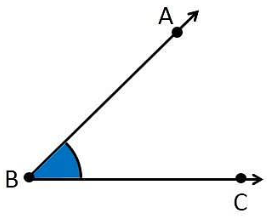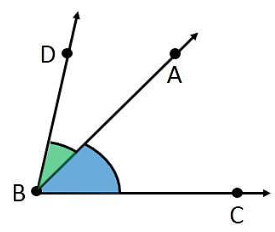
Answer
426k+ views
Hint: First draw an acute angle ABC with vertex at B and AB and BC as its sides. Now, take another point D outside the angle ABC and join BD to form the second angle ABD. From the figure, you will see that only points A and B, and the ray AB are the common elements between the two angles.
Complete step by step solution:
In this question, we need to draw rough diagrams of two angles such that they have:
One point in common, Two points in common, Three points in common, Four points in common, One ray in common
(a) First, we will draw an angle ABC with vertex at B and AB and BC as its sides.

Here, we have three points: B as the vertex and A and C on the sides of the angle ABC.
Now, we will take another point D outside the angle ABC and join BD to form the second angle ABD.

Now, from this new figure, we can see that the angles ABC and ABD have the point B common.
(b) Construct the diagram same as in part (a). We see that the angles ABC and ABD have two points in common. These are point B and point A.

(c) Since, we can have only one endpoint, hence it is impossible to draw two angles such that they have three points in common.
(d) Since, we can have only one endpoint, hence it is impossible to draw two angles such that they have four points in common.
(e) Construct the diagram same as in part (a). We see that the angles ABC and ABD have the ray AB common.

Note: Another different approach to this problem can be: We draw the same figure as before for the two angles. Now we know that a ray has an infinite number of points. So, on the common side, we choose 2 additional points P and Q which are common to both the angles. In this way, two angles can have 4 common points. Similarly, we can have 3 common points.

Complete step by step solution:
In this question, we need to draw rough diagrams of two angles such that they have:
One point in common, Two points in common, Three points in common, Four points in common, One ray in common
(a) First, we will draw an angle ABC with vertex at B and AB and BC as its sides.

Here, we have three points: B as the vertex and A and C on the sides of the angle ABC.
Now, we will take another point D outside the angle ABC and join BD to form the second angle ABD.

Now, from this new figure, we can see that the angles ABC and ABD have the point B common.
(b) Construct the diagram same as in part (a). We see that the angles ABC and ABD have two points in common. These are point B and point A.

(c) Since, we can have only one endpoint, hence it is impossible to draw two angles such that they have three points in common.
(d) Since, we can have only one endpoint, hence it is impossible to draw two angles such that they have four points in common.
(e) Construct the diagram same as in part (a). We see that the angles ABC and ABD have the ray AB common.

Note: Another different approach to this problem can be: We draw the same figure as before for the two angles. Now we know that a ray has an infinite number of points. So, on the common side, we choose 2 additional points P and Q which are common to both the angles. In this way, two angles can have 4 common points. Similarly, we can have 3 common points.

Recently Updated Pages
The radius of curvature of a plane mirror is a positive class 10 physics CBSE

Choose the word which is closest to the opposite in class 10 english CBSE

Select the antonym for the following word from the class 10 english CBSE

Select the synonym for the given word Transparency class 10 english CBSE

Select the given word which means the opposite of the class 10 english CBSE

The purest form of carbon is a Graphite b Diamond c class 10 chemistry CBSE

Trending doubts
How do you graph the function fx 4x class 9 maths CBSE

Which are the Top 10 Largest Countries of the World?

Fill the blanks with the suitable prepositions 1 The class 9 english CBSE

What is the meaning of sol in chemistry class 11 chemistry CBSE

The Equation xxx + 2 is Satisfied when x is Equal to Class 10 Maths

The capital of British India was transferred from Calcutta class 10 social science CBSE

Why is there a time difference of about 5 hours between class 10 social science CBSE

Capital of the Cheras was A Madurai B Muziri C Uraiyur class 10 social science CBSE

What organs are located on the left side of your body class 11 biology CBSE




